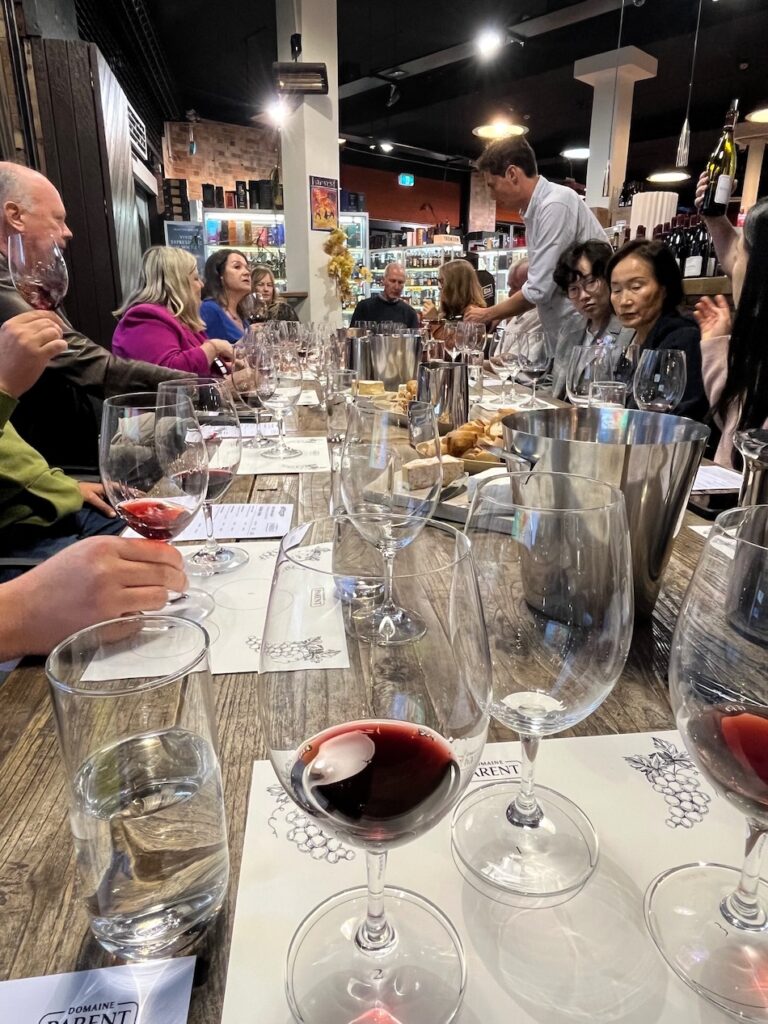This is my first Tasting at Glengarry for the year. Nick and Jarrod are the hosts for an intimate evening, down at the Victoria Park store. Zack from the Jervois Road Glengarry and Aroha Jakicevich, from the family owners, are also here for the event. One of the more familiar appellations in the Côte d’Or in Burgundy – to New Zealand consumers – is Pommard. There is a link to some of the very earliest vines of Pinot Noir to arrive in New Zealand, that were taken from Pommard and imported via UCD in America – and are known here as ‘Clone 5’. Pommard is just down from the central town of Beaune – about the first place you’d come to if travelling south from there. It neighbours Volnay, and then you’re heading into white wine territory.
‘Cote d’Or’ is a new appellation – introduced in 2017. It is technically a new geographical denomination within the regional ‘Bourgogne’ appellation, with an aim to highlight the greater potential of the Côte d’Or, in the heart of Burgundy, to produce unique wines. Designed to be a cut above the regional Bourgogne appellation, there are qualifying criteria – such as yields must be lower compared to wines labelled simply Bourgogne (which may contain grapes grown anywhere in the wider Burgundy area). In the past you might be disappointed by a thin Bourgogne Rouge, which would often be made entirely from grapes grown in the less prestigious parts of Burgundy.
Domaine Parent are a quintessential producer of the appellation. The Parent family can trace their roots back to Etienne Parent who, in 1787, established a professional and friendly relationship with US President Thomas Jefferson who visited the region. The Parent family have been a permanent fixture in Pommard since this time, with the sixth generation, sisters Anne and Catherine now in charge. They have about ten hectares, farmed organically, in total – in Pommard.
We start with their Crémant de Bourgogne Brut Blanc 2019. The cépage is 30% Pinot Noir, 50% Chardonnay, 16% Aligoté and 4% Gamay. The Pinot giving a rounded fruitiness, the Chardonnay adds a drier, more acidic element and the Aligoté is quite austere. Gamay has vivacity. Made in the same method as Champagne of course. A dosage of 4.5 g/l of added sugar. The bouquet is quite biscuity, yeasty with brioche and baguette notes alongside citrus, apple and a little reductive funk adding character. A fine mousse of bubbles with a delicious, youthful energy into the palate. Brisk acidity and quite dry, there’s a distinct white pepper to the finish. Very classy.
In Burgundy, there is often a very clear distinction between vintages – the wines are not necessarily the same year-in, year-out. In fact, this vintage variation is embraced as part of the deal with farming, where you deal with what Mother Nature gives you and make the wines according to the crop. It’s noted that actually Anne Parent prefers the years where there is ‘more work’ to be done to produce a quality product, compared to the ‘easy years’ where anyone can make a decent drop.

The first two Pinots are a case in point. The Bourgogne Cote d’Or 2020 and Bourgogne Cote d’Or 2021 are miles apart in terms of presentation and taste. My personal preference is for the 2021 (although, to be clear, I’m very much in the minority in the room with this opinion!). The 2020 is a lovely glass of red wine, but the 2021 is much more clearly Pinot Noir. However, I did keep the two samples, and returning to taste again after half an hour, I couldn’t see any improvement in the ’21 – it was still light and delicate with a pop of crunchy red fruits, but some of the fine fragrance had muted and it had lost a little of the initial, pretty charm. The ’20 was much bolder, with bloody, dark flavours. A solid ‘blocky’ style from a warm vintage – this was still very primary and is good drinking for an entry-level example.
As well as the wines, there are a couple of rather good cheeses on the table, which are a very good foil to the wines. A subtly nutty Brie ‘Mon Sire’ comes from the east of France; and a rich, washed rind cheese ‘Galactic Gold’ from Over the Moon, made in Putaruru, New Zealand. Even the bread, which comes from BeaBeas Bakery on Garnet Road in Westmere is beyond your basic baguette. It’s chewy and yet soft. Just what you want with a tasting.
There is no ‘Grand Cru’ designation in Pommard. Les Grands Epenots, and Les Rugiens are considered to be the best terroirs in the region, and the next two reds – La Croix Blanche Village Pommard 2019 and Croix Noires 1er Cru 2017 come from the neighbouring plots. The 2019 has a lovely floral lift to the nose. Solid in structure, with a marmite, iron earth quality – savoury but still juicy and bright acidity. The Premier Cru is very forward and attractive – more Volnay-like. Lots of spice initially, with softer fruits piling in behind – strawberry and elderberry come to mind. There’s a savoury ‘hedgerow’ feeling to it too – with some quirky flavours like roasted carrot and root beer as well. The texture has a creamy quality. The finish is lengthy, with a peppery note.
The french make superb Chardonnay, and Parent have a decent Bourgogne Blanc 2019 to try tonight. Pithy, leesy and mineral, but clean, pure and with a lovely unpolished personality. Grapefruit, lemon peel and with no discernible oak masking the flavours. In fact, the range tasted tonight doesn’t show oak as a character throughout. There’s a fine, dry finish to the white. To my mind, compared to a New Zealand wine of similar standing, it lacks a little fruit and oomph.
It’s an excellent evening, with a good balance between information, opinion and ability to have a discussion around the table – something that can be lost at larger tastings. At $45 it represents very good value, and the discounts on offer off the RRP for those attending, make it an even better proposition for anyone looking to gain some knowledge, and then the confidence to take a step into buying some wines from the ‘fine wine’ end of the spectrum.




